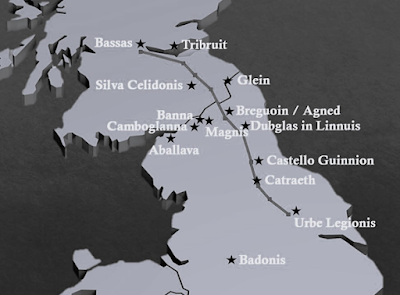Hadrian's Wall, Showing Castlesteads (Camboglanna/Camlann), Burgh By Sands (Aballava/Avalana/"Avalon") and Drumburgh (Concavata, a word equivalent to "Grail") in Relation to Birdoswald/Banna and Carvoran/Magnis
Dea Latis ('Lake Goddess') from Burgh By Sands
Dea Latis from Birdoswald
Arthurian Battles Along with Hadrian Wall Forts Of Magnis, Banna, Camboglanna and Aballava
It is with a degree of sadness that I've decided to drop the Welsh and Cornish identifications of Uther Pendragon with the terrible magister militums Illtud and Gerontius (later Gereint).
I've come to the conclusion, after reviewing my huge body of earlier work on the probable presence of Arthur on the Wall, that the various strands of tradition that sought to restrict him to the Celtic Fringe in the South are not reliable indicators of sound historical nuclei.
This has been a very difficult decision for me to make. But the earliest sources (HISTORIA BRITTONUM and the ANNALES CAMBRIAE), when combined with archaeology and place-name studies, in addition to what little can be gleaned from (admittedly, manipulated and sometimes wholly manufactured) genealogies, has led me to the conclusion that the REAL Arthur belongs at Banna, although his maternal line may be traceable to neighboring Carvoran.
The full argument in support of all this will be reissued in a final version of my book THE BATTLE-LEADER OF THE NORTH. There I discuss the presence at Carvoran of a late Roman period Dalmatian garrison. L. Artorius Castus had major Dalmatian connections and it is even possible he was born there. After taking three legionary vexillations to Armenia under Statius Priscus, he was made procurator with the right of the sword over Liburnia, a new province carved out of Dalmatia on an emergency basis in the face of the Marcomannic Wars. We have evidence of Artorii in Salona, and a woman from that city was buried at Carvoran. Another late Dalmatian unit served at York, where Castus had been stationed as prefect of the Sixth Legion.
Banna was manned in the late period by a Dacian unit whose ethnic distinctiveness is proven by the presence on stones there of the Dacian falx, their peculiar scythe-like sword. I have written extensively on the Dacian wolf-headed draco, proving from an early archaeological find that this draco did possess a scaled body. I have also demonstrated that there is not one shred of evidence for the draco among the Sarmatians. While some such standard might be assumed, the sources - literary and archaeological - do not provide us with the means to show that they did possess a draco. Experts on the Sarmatians have reluctantly confirmed this fact for me. An oblique reference in a Classical source to Scythians with the draco refers not to Sarmatians, but to Alans.
I've also suggested (and received significant positive feedback from professionals on the idea) that the dragon referred to on the Staffordshire Moors Cup is a reference to Banna of the Aelian Dacians, who may have been noted for their special fondness for the draco. A Terrible Chief-dragon or Chief of dragons at Banna would be a good title for their leader. We also know of a late Roman rank of magister draconum for the leader of the draco-bearers and it is not impossible that this rank is the origin of the Pendragon epithet.
I realize there will be a lot of Arthurian fans who are displeased with my jettisoning of the Southern Arthur. After all, the Welsh and Cornish Arthurs are what we have gotten used to, and are what we have come to expect. But it doesn't follow that either of them represent the historical Arthur. And it has always been this last whom I have been most interested in finding.




No comments:
Post a Comment
Note: Only a member of this blog may post a comment.